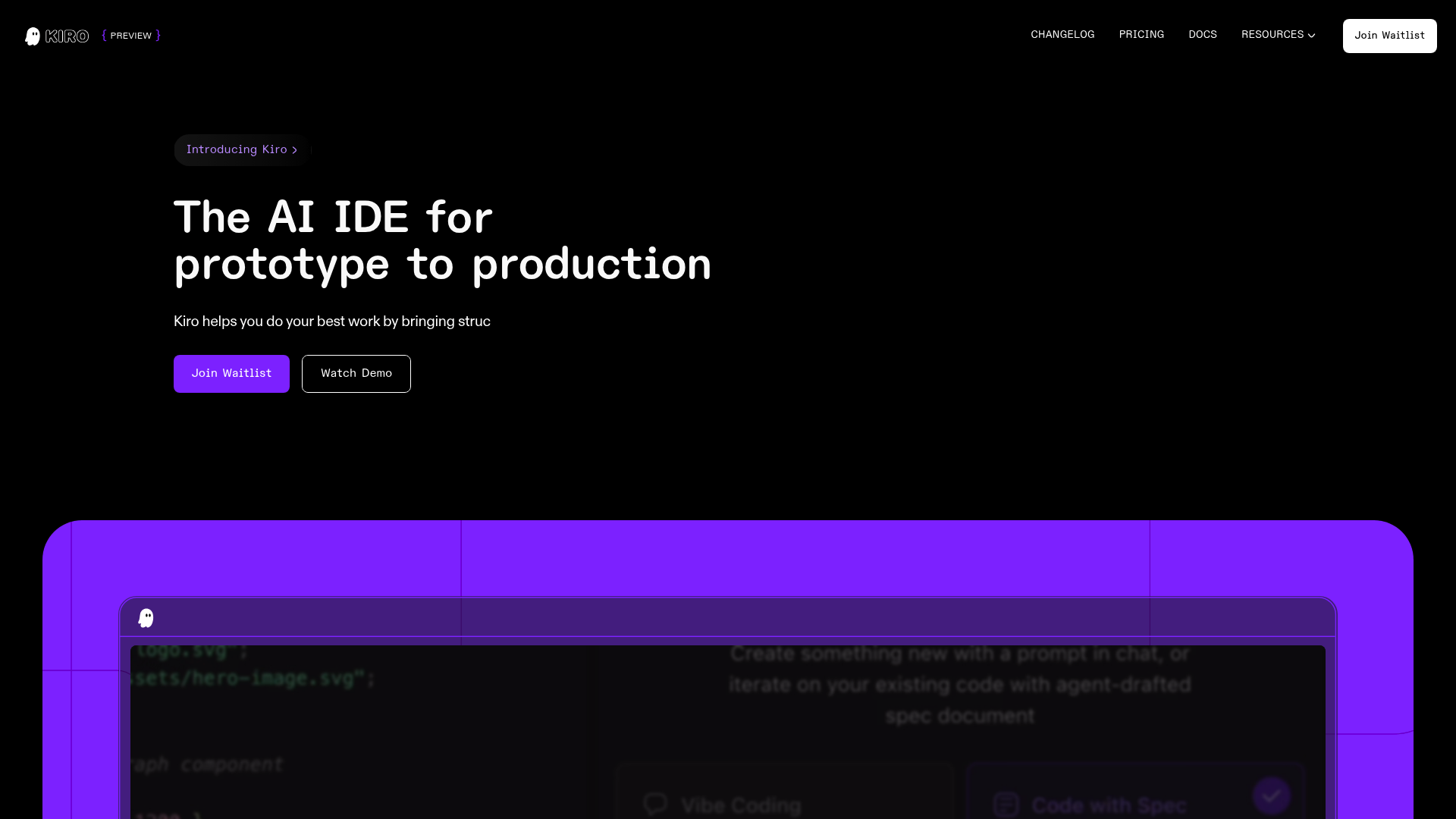Kiro is an AI-native IDE that transforms how developers build applications through spec-driven development, multimodal chat, and agent hooks, enabling seamless transitions from prototype to production with advanced context management and autonomous task execution.
Core Functionality & Use Cases
Kiro serves as an AI IDE for prototype to production development, fundamentally changing how developers approach software creation. Unlike traditional coding assistants that focus on autocomplete or single-file generation, Kiro enables goal-oriented development where you can request complex features like "add user authentication" or "create a REST API for the product module."
The platform excels in several key scenarios:
Enterprise Application Development: Developers have rapidly built enterprise-grade applications including HR automation platforms powered by Amazon Bedrock Nova Premier with intelligent resume ranking and AI-powered candidate scoring. The system supports advanced search capabilities and skill-based filtering for comprehensive talent management solutions.
Full-Stack Web Development: Teams create dynamic calendar applications showcasing event management with categorized filtering and interactive design, demonstrating Kiro's ability to handle complex user interface requirements alongside backend functionality.
Automated Quality Assurance: The IDE includes automation features through "agent hooks," allowing Kiro to automatically update documentation, generate tests, or perform security checks when files are modified or new commits are made, maintaining quality standards without manual intervention.
The primary target audience includes professional developers, software engineering teams, startup founders building MVPs, and organizations seeking to accelerate their development cycles while maintaining code quality and documentation standards.
Distinctive Advantages & Unique Value Proposition
Specification-Driven Architecture
Kiro's spec-driven workflow supports developers from prompt to production, setting it apart from traditional AI coding tools. The tool reflects Amazon's internal engineering practices and is designed to help developers scale from small ideas to robust, production-ready systems.
Multi-File Context Understanding
Kiro analyzes and edits multiple files in your project, enabling end-to-end feature development, while every change Kiro makes is shown transparently. This contrasts sharply with tools like GitHub Copilot, which works at the token level, predicting the next word or code line as you type, but is limited to working within a single file and immediate context.
Advanced Integration Capabilities
Kiro connects to docs, databases, APIs, and more with native MCP integration so you can bring your world where you work. It integrates with AWS services (Bedrock, IAM), but can also be used in other environments, providing flexibility across different cloud platforms and development ecosystems.
Autonomous Task Execution
Kiro can autonomously run large tasks on its own without needing step-by-step instructions, while you stay in control, especially when running scripts. This autonomous capability significantly reduces development time for complex features while maintaining developer oversight.
Superior Code Quality & Structure
Developers have praised the emphasis on specs, hooks and structure, comparing it favorably to tools like Claude Code and Cursor, citing the improved rigor in building and documenting features. The platform enforces best practices through its architectural approach rather than relying solely on developer discipline.
Pricing Structure & Cost Model
During the preview period, users can take advantage of reasonable limits at no cost. Kiro is free during preview, with some limits, making it accessible for developers to explore its full capabilities without financial commitment.
The current pricing model follows a freemium approach during preview:
- Free Preview Access: Complete IDE functionality with usage limits
- No Registration Barriers: Users can sign in with one of four login methods including Google and GitHub
- Cross-Platform Support: Support for Mac, Windows, and Linux, and most popular programming languages
While specific post-preview pricing details haven't been announced, the platform's enterprise-grade features and AWS backing suggest future subscription tiers will likely cater to individual developers, teams, and enterprise customers with varying feature sets and usage limits.
Getting Started with Kiro
Beginning your journey with Kiro involves several straightforward steps:
-
Download and Installation: Visit the downloads page and agree to the AWS Customer Agreement, Service Terms, and Privacy Notice to access the platform across supported operating systems.
-
Account Setup: Sign in using Google, GitHub, or other supported authentication methods to access your development environment.
-
Tutorial Completion: Complete the hands-on tutorial that walks you through building a complete application, providing practical experience with spec-driven development workflows.
-
Community Engagement: Join the Discord server for community support and feedback to connect with other developers exploring Kiro's capabilities.
The platform's familiar VS Code-based interface ensures minimal learning curve for experienced developers while introducing powerful new paradigms for AI-assisted development. You can start with vibe conversations and then generate specs, with Kiro asking if you want to start a spec session based on your conversation context.
Frequently Asked Questions
Q: How does Kiro differ from other AI coding assistants? A: Kiro focuses on specification-driven development and provides built-in hooks for tests, documentation, and security checks, offering a more structured approach than traditional autocomplete tools.
Q: Can Kiro work with existing codebases? A: Yes, Kiro understands the intent behind your prompts and helps implement complex features on larger codebases, in fewer shots, making it suitable for both new projects and legacy code enhancement.
Q: What programming languages does Kiro support? A: Kiro supports most popular programming languages and works across Mac, Windows, and Linux environments.
Q: Is there a learning curve for spec-driven development? A: You can have a vibe conversation and then say Generate spec, with Kiro proceeding to generate requirements based on your conversation context, easing the transition to structured development.
Q: How does Kiro handle code quality and testing? A: Agent hooks automatically update documentation, generate tests, or perform security checks when files are modified or new commits are made, ensuring consistent quality standards.
Q: Can teams collaborate using Kiro? A: Cross-repository workflows support processes for proposing, reviewing, and updating shared specs that affect multiple projects, enabling effective team collaboration.
Q: What makes Kiro's approach to AI development unique? A: Kiro aims to solve the fundamental problem that software development is still messy and fragmented, with specs being a major step toward organized development, representing a systematic approach to AI-assisted programming.
